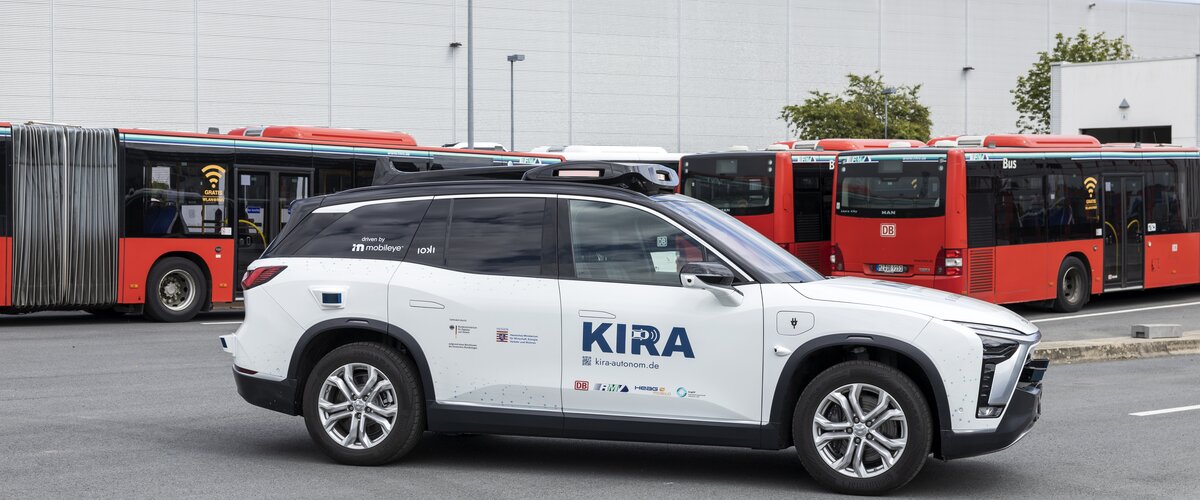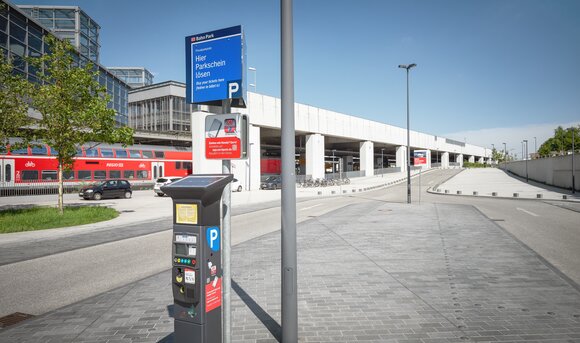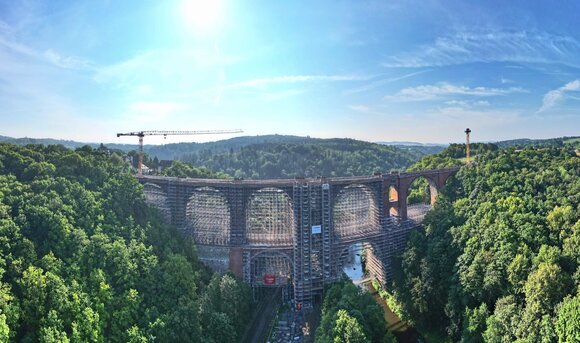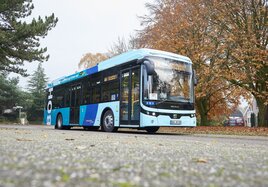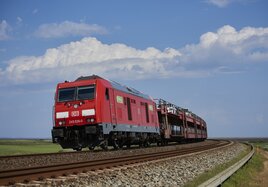Deutsche Bahn also wants to create climate-friendly and attractive offers for its customers outside of the rail network. In rural areas in particular, there are often still few or inadequate local public transport services. In view of staff shortages and economic conditions, autonomous public service vehicles and on-demand shuttles can play a key role in ensuring comprehensive public transport and a climate-friendly switch from cars to buses and trains.
DB is therefore testing the use of autonomous electric vehicles in public transport in various projects.
KIRA: Autonomous shuttles in the Rhine-Main region
KIRA, "AI-based regular operation of autonomous on-demand transport", is the first project in Germany to test autonomous vehicles at level 4 in regional and local passenger transport. Level 4 means that a vehicle moves autonomously within a defined area, i.e. effectively driverless. The special feature: For the first time, the decision on all driving maneuvers lies with the vehicle. In test operation, safety personnel are always on board. DB Regio and the Rhein-Main transit authority (RMV) are the initiators of the project and are coordinating it jointly.
The electric vehicles are used in regular road traffic in the Offenbach district. Although safety personnel are still on board as part of the trial, the shuttles drive autonomously, at normal speed and overcome complex traffic situations. Customers can now book and use the shuttles in the city of Langen and the municipality of Egelsbach in the Offenbach district. They must be registered as test users and require the project's own KIRA app. In the second half of the year, this should also be possible in parts of Darmstadt. The aim of the KIRA project is to prove the suitability of autonomous on-demand transport for regular operations - especially in rural areas. In the long term, the shuttles are to operate completely without personnel, monitored by technical supervision in a control center, which is already being tested as part of KIRA.
The DB company ioki is providing the software for booking and route planning; ioki is also integrating the software components of the various technology partners. Another partner, Mobileye, is providing the software and hardware for the autonomous driving system. The findings from this pilot project will be summarized in a guideline for the entire industry.
ULTIMO: European research project to scale up autonomous driving
In order to further increase the economic efficiency and regular operation of autonomous vehicles, DB Regio is leading the European research project ULTIMO in collaboration with various project partners. Vehicles for on-demand transport and logistics services are being tested in Geneva, Oslo and Herford. In Oslo, five level 4 NIO vehicles with Mobileye technology have been in trial operation since the end of 2023. Further autonomous on-demand transports will follow in Geneva and Herford in 2025.
Bad Birnbach: First autonomous bus line tested in Bavaria
In 2017, DB Regio launched the first autonomous bus in regular service in Germany in Bad Birnbach. In 2022, an autonomous on-demand shuttle was added, which made it easier to reach health facilities and stores for everyday needs along 20 virtual stops. The shared ride-hailing software for the HEAL research project (Highly Automated, Demand-Responsive, Rural) came from DB subsidiary ioki. The autonomous vehicles in Bad Birnbach have thus made innovation history and covered over 123,000 kilometers in autonomous operation from October 2017 to the end of 2024. Autonomous operation was discontinued for the time being at the end of 2024.
With projects such as KIRA, ULTIMO and HEAL, Deutsche Bahn is driving forward the decarbonization of mobility. The aim is to make public transport more sustainable, safer and more attractive. DB is also supporting other research and development projects in the field of autonomous driving, such as the "RABus" project in Friedrichshafen and Mannheim and "Belntelli" in Berlin. In this way, it is creating viable mobility offers for the future that cover both urban and rural areas and thus enable equal mobility for all.
Complex service package for the industry
For autonomous driving to function successfully, effective interaction between various components and partners is necessary. DB Regio plays a central role here by bundling all technical and operational components into a holistic mobility solution and making it available to the various local transport authorities. It uses the control platform and shared ride-hailing software of DB's own subsidiary ioki, prepares feasibility studies, coordinates approval processes and takes over the operation of autonomous transport services on behalf of the local transport authorities.
